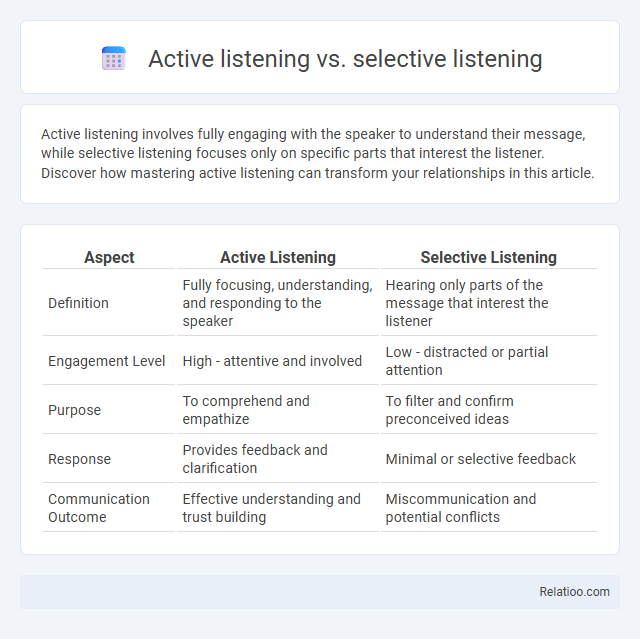Active listening involves fully engaging with the speaker to understand their message, while selective listening focuses only on specific parts that interest the listener. Discover how mastering active listening can transform your relationships in this article.
Table of Comparison
| Aspect | Active Listening | Selective Listening |
|---|---|---|
| Definition | Fully focusing, understanding, and responding to the speaker | Hearing only parts of the message that interest the listener |
| Engagement Level | High - attentive and involved | Low - distracted or partial attention |
| Purpose | To comprehend and empathize | To filter and confirm preconceived ideas |
| Response | Provides feedback and clarification | Minimal or selective feedback |
| Communication Outcome | Effective understanding and trust building | Miscommunication and potential conflicts |
Understanding Active Listening
Active listening involves fully concentrating, understanding, and responding thoughtfully to the speaker, enhancing communication effectiveness and empathy. Selective listening, by contrast, filters information based on personal biases or interests, often leading to misunderstandings or incomplete comprehension. Understanding active listening requires prioritizing empathy, feedback, and nonverbal cues to foster deeper connections and accurate message interpretation.
Defining Selective Listening
Selective listening is the process of focusing on specific sounds or messages while ignoring others, often driven by personal interests or biases. Unlike active listening, which involves fully concentrating, understanding, and responding to all incoming information, selective listening filters out parts of the conversation that are perceived as less relevant. This listening style can impact effective communication by causing misunderstandings or missed details due to the listener's partial attention.
Key Differences Between Active and Selective Listening
Active listening involves fully concentrating, understanding, and responding to the speaker, ensuring effective communication and retention of information. Selective listening, however, focuses only on specific parts of the conversation that interest the listener, often leading to missed details and misunderstandings. The key difference lies in active listening's intent to engage and comprehend entirely, whereas selective listening filters information based on personal preference or bias.
Benefits of Active Listening
Active listening enhances communication by fully engaging with the speaker, leading to improved understanding, trust, and stronger relationships. Unlike selective listening, which filters information and risks missing key details, active listening ensures you capture the complete message and respond thoughtfully. Your ability to practice active listening boosts collaboration, reduces misunderstandings, and fosters a more inclusive and productive environment.
Drawbacks of Selective Listening
Selective listening often leads to misunderstanding and miscommunication as key information may be ignored or overlooked, reducing overall comprehension and collaboration. This listening style can foster bias, as individuals tend to hear only what aligns with their preconceived notions, weakening critical thinking and problem-solving abilities. Unlike active listening, which promotes full engagement and empathy, selective listening undermines relationship building and effective communication within both personal and professional contexts.
Skills Involved in Active Listening
Active listening involves fully concentrating, understanding, and responding thoughtfully to the speaker, utilizing skills such as empathy, patience, and verbal feedback to ensure clear communication. Selective listening, by contrast, filters information based on personal interests or biases, often missing critical details and diminishing overall understanding. You can enhance your communication effectiveness by mastering active listening skills like maintaining eye contact, nonverbal cues interpretation, and summarizing key points for clarity.
Common Reasons for Selective Listening
Selective listening often occurs due to distractions, preconceived notions, or emotional biases that limit full engagement with the speaker's message. Your mind may prioritize certain information based on personal interests or relevance, causing critical details to be ignored or misunderstood. Understanding the common reasons behind selective listening can help enhance your active listening skills and improve overall communication effectiveness.
Impact on Communication and Relationships
Active listening fosters deeper understanding and trust by fully engaging with the speaker, enhancing your relationships through clear and empathetic communication. Selective listening, which filters information based on personal biases or interests, can lead to misunderstandings and weaken communication effectiveness. By prioritizing active listening over selective approaches, you improve connection quality, reduce conflicts, and support stronger interpersonal bonds.
Strategies to Improve Active Listening
Active listening involves fully concentrating, understanding, and responding thoughtfully, whereas selective listening means hearing only parts of a conversation that interest or benefit the listener, often leading to misunderstandings. Strategies to improve active listening include maintaining eye contact, avoiding interruptions, providing feedback through paraphrasing, and minimizing distractions to enhance comprehension and engagement. Training in mindfulness techniques and practicing empathetic listening further strengthens active listening skills by fostering genuine connection and clarity.
Overcoming Barriers to Effective Listening
Active listening requires fully engaging with the speaker by paying close attention, interpreting meaning, and providing feedback, which helps overcome barriers like distractions and preconceived notions. Selective listening involves filtering information based on personal interests, often leading to missed important details and misunderstandings. You can enhance communication and overcome listening barriers by practicing active listening skills such as maintaining eye contact, minimizing internal biases, and summarizing key points for clarity.

Infographic: Active listening vs Selective listening
 relatioo.com
relatioo.com